Pignoli cookies are crunchy Sicilian almond cookies coated with toasted pine nuts and a sweet and chewy almond paste center. These gluten free cookies are traditionally a way to celebrate holidays and special occasions, but they’re deceptively simple to make.
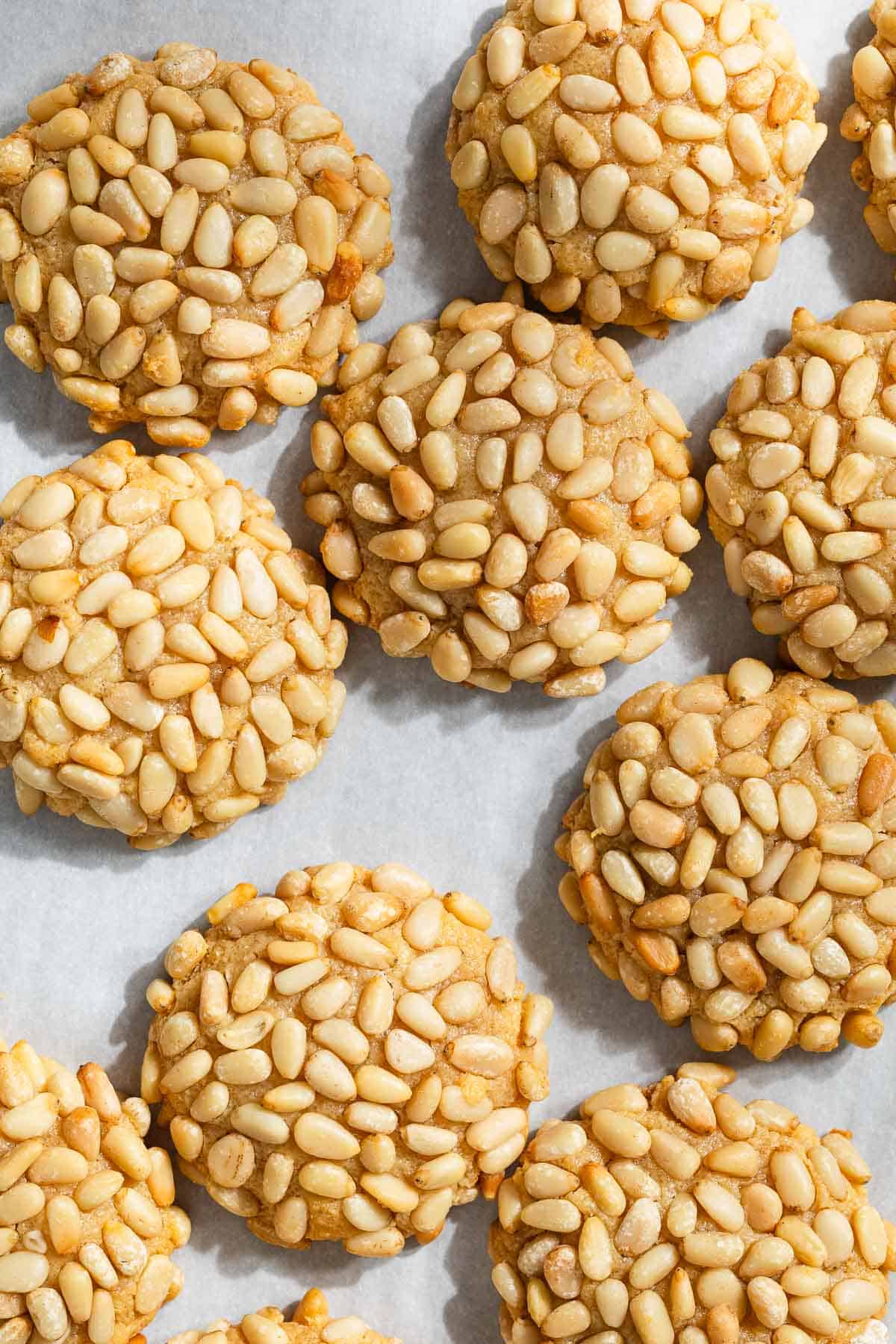
Many special occasion desserts have too many ingredients or too many steps when there’s already so much to do around the holidays. Pignoli cookies feel special, but not because of how difficult they are. In fact, you’ll be surprised how easy these pine nut-studded delights are to make at home.
Just like Egyptian Ghorayebah or Italian Baci Di Dama, these Sicilain cookies have a humble list of few ingredients. But because almond paste and pine nuts were once considered luxury ingredients they have a long history of marking special occasions.
Made from just almond paste, sugar, and egg white, they’re naturally gluten-free and dairy-free, making this pignoli cookie recipe a friendly holiday treat for those with dietary restrictions. Just be sure to make plenty as they’re a sure hit for the entire guest list!
Table of Contents
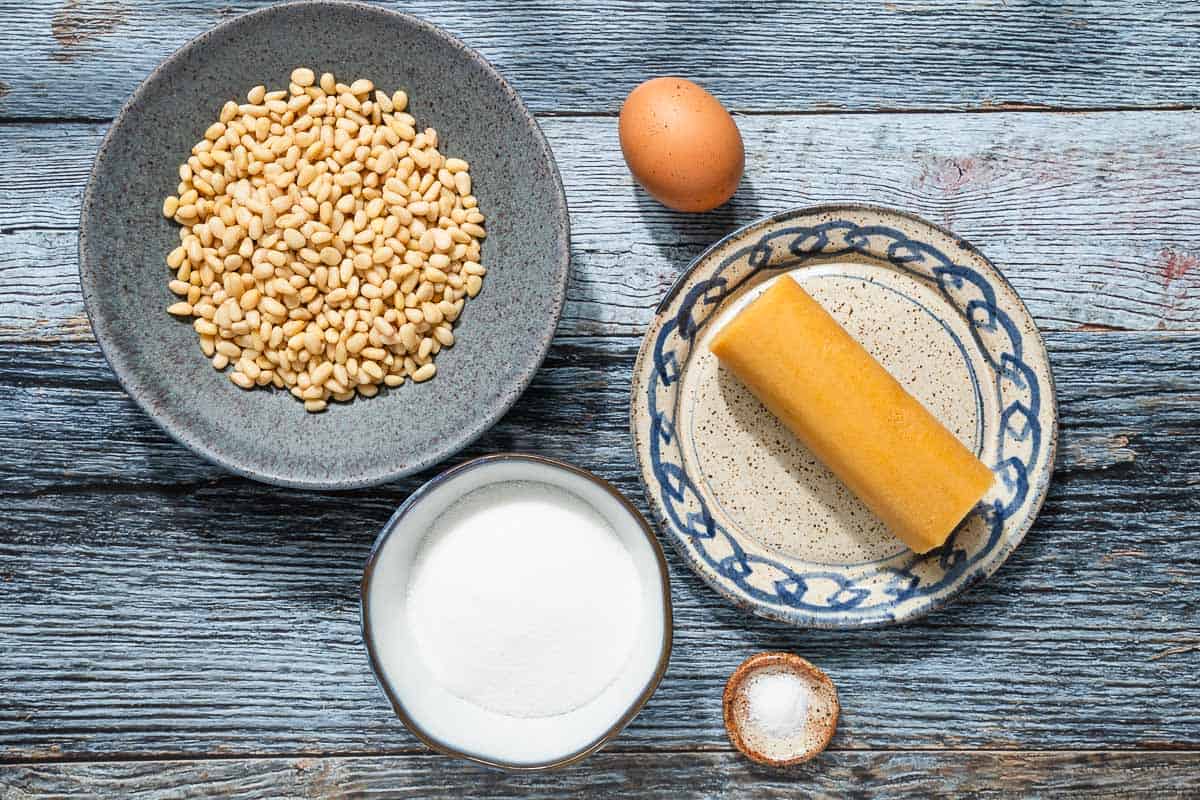
Pignoli Cookies Ingredients
With just 5 ingredients (even counting the salt!), this pignoli cookie recipe has an exceptionally short ingredient list. You’ll find almond paste and pine nuts in the baking aisle of most grocery stores or specialty food stores, or you may get a better deal online.
- Almond paste: Almond paste is made from finely ground almonds and sugar. It makes these cookies rich and chewy with a bittersweet almond flavor. Almond paste is not the same as marzipan and marzipan does not make a good substitute (see “Understanding Almond Paste” below for more information).
- Granulated sugar: Sweetens the cookies.
- Egg white: Holds the dough together and prevents the cookies from spreading too much in the oven.
- Salt: Salt is a flavor enhancer and helps mellow out the bitterness that sometimes comes with almonds.
- Pine nuts: These mild and buttery nuts really do come from pine trees. They’re versatile and used in both sweet and savory recipes, like pesto. Here, they bring the cookie’s signature buttery, toasty flavor, along with a nice crunch.
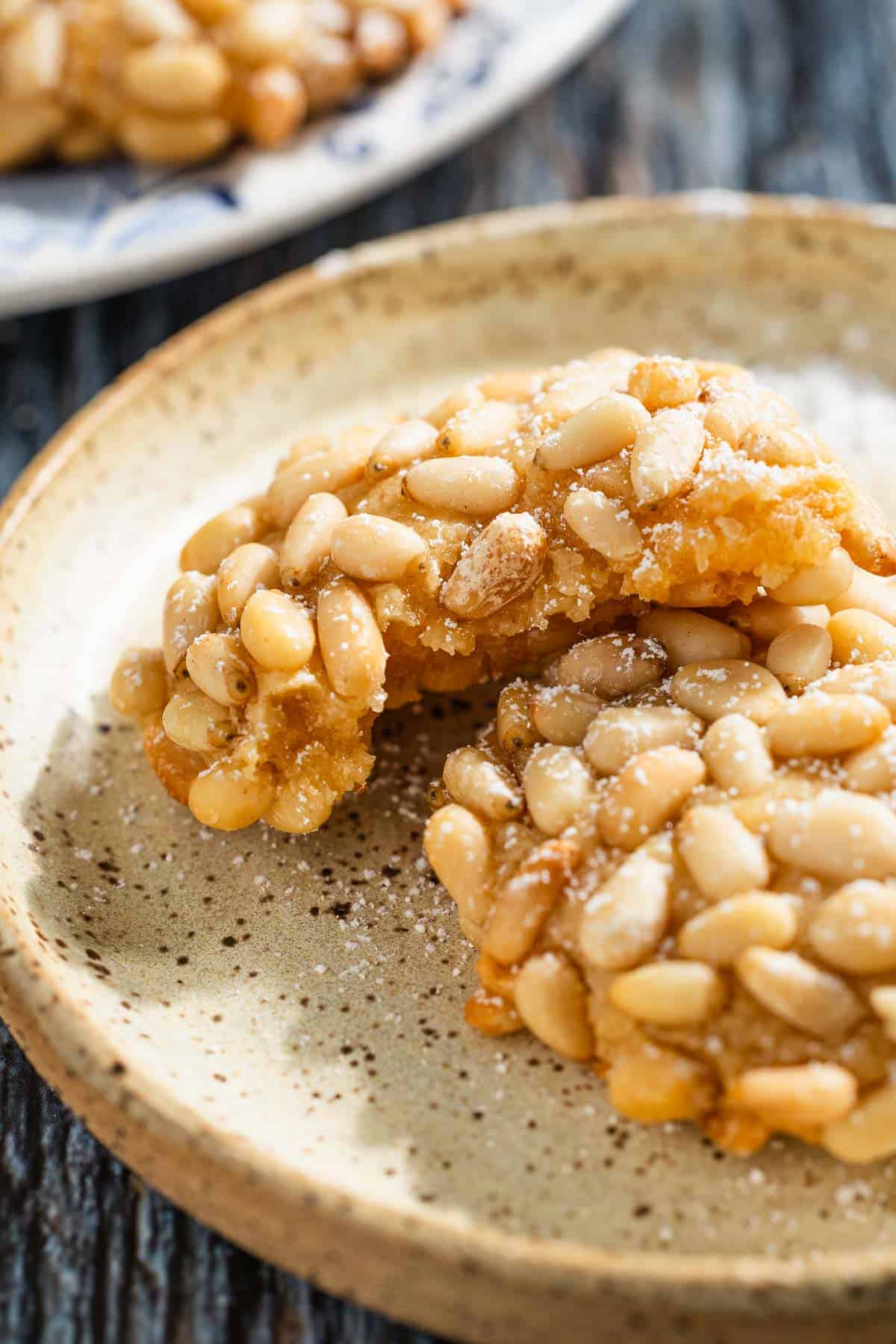
What is Almond Paste?
Almond paste is a sweet paste made from ground almonds and sugar. It adds a rich almond flavor to baked goods and makes moist and velvety cakes.
Don’t confuse almond paste with marzipan, and note that they are not interchangeable. While almond paste is generally used as an ingredient in batters or as a filling, marzipan is used to decorate cakes or it can be eaten as a candy.
In the US, almond paste and marzipan are not strictly defined like they are in other countries. And, even where defined, the almond and sugar content requirements vary greatly by country. You can generally count on almond paste to contain about twice as much ground almonds as marzipan.
For example, Odense almond paste, my preferred brand, contains 45% almond, whereas their marzipan is only 28% almond, with the rest being sugar. Odense is made from just almonds, sugar, and glucose syrup. Check the ingredient list of the brands available to you and avoid those that use corn syrup, or ground apricot or peach kernels to decrease costs.
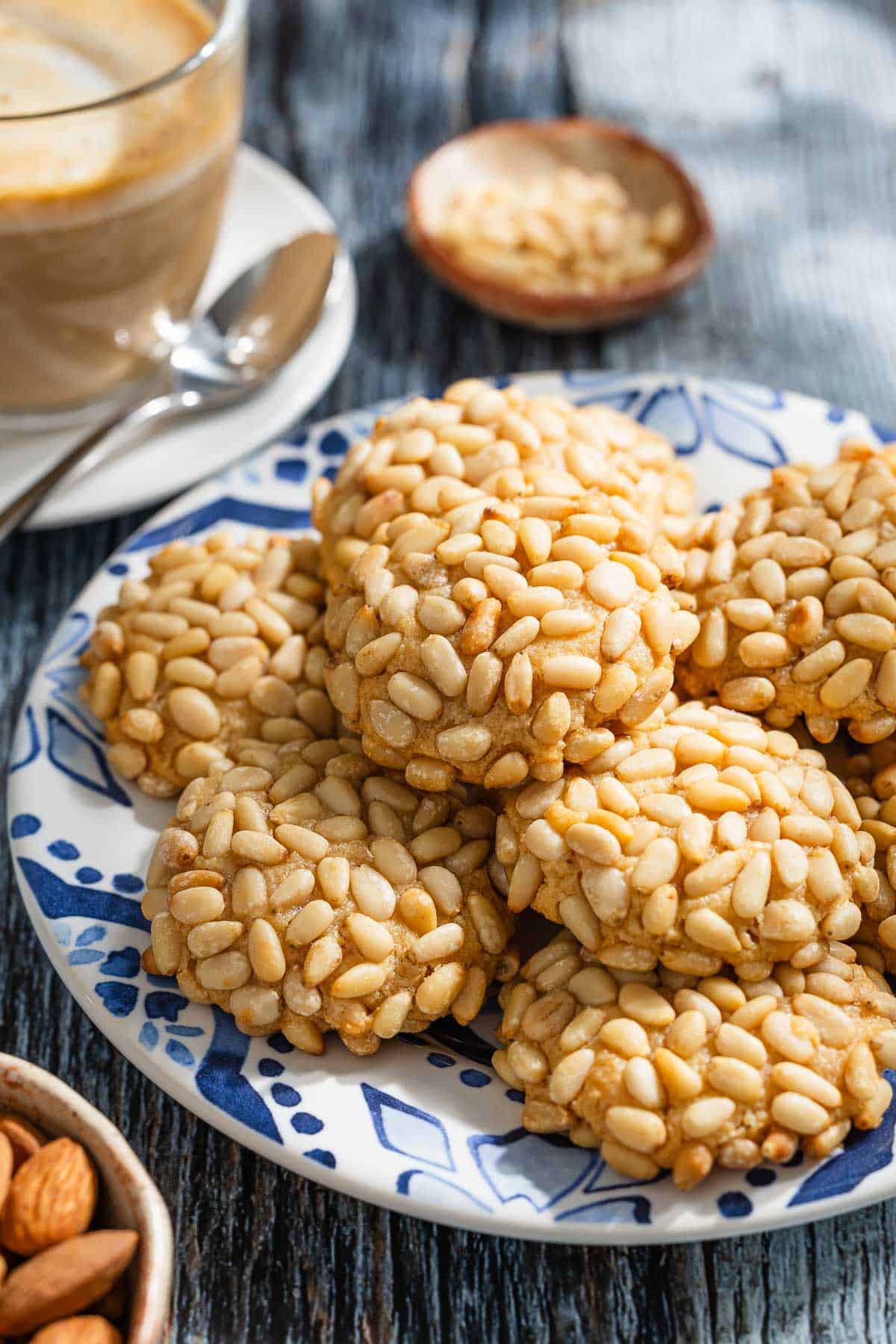
How to Make Pignoli Cookies
Quick and easy to make, pignoli cookies are ready in less than an hour. This pignoli cookie recipe is for a batch of 12. Depending on the size of your food processor you could easily double or triple the recipe.
- Preheat the oven to 350°F: Arrange a rack in the center of the oven and preheat to 350°F. Line a baking sheet with parchment paper.
- Make the dough: Slice or break apart 7 ounces of almond paste into small pieces and add to the bowl of a food processor. Add 1/2 cup sugar, 1 egg white, and 1/4 teaspoon salt, and process until it forms a thick, smooth paste, about 1 minute. Pause halfway through to scrape the bottom and sides of the bowl to ensure there are no unblended lumps of almond paste.
- Scoop the cookies: Scoop 12 rounded tablespoons of the dough (about 25 grams each) and roll each mound into a ball in the palms of your hand. If the dough is too sticky to work with, you can chill the dough, covered, for 10 to 15 minutes.
- Coat with pine nuts: Add the pine nuts to a wide, shallow bowl. Roll each ball of dough in the pine nuts, coating the entire surface. Gently press the pine nuts into the dough to encourage them to stick.
- Bake: Place the cookies on the prepared baking sheet, spacing them about 2 inches apart. Bake for 18 minutes, or until the pine nuts and the edges of the cookies begin to turn golden.
- Cool: Let the cookies cool completely on the pan before serving.
Tips, Tricks, and Trouble Shooting
As simple as pignoli cookies are to make, here are a few techniques I found helpful for mixing, shaping, and cooling for stress-free pignoli cookies.
- If you don’t have a food processor: Use a stand mixer with the paddle attachment. It will take a few minutes longer as you wait for the almond paste to form a smooth dough. Crumble the almond paste into small pieces and beat it with the sugar and salt until the almond paste has broken up into small pieces. Add the egg white and mix until smooth.
- If the dough is too sticky: The dough is naturally fairly sticky, which can be frustrating to work with. You can scoop the dough directly into the bowl of pine nuts, using the pine nuts as you would flour to prevent it from sticking to your hands while shaping the cookies. I found that chilling the dough in the fridge or freezer for a few minutes also helps as it gets stickier.
- To avoid breaking: After baking, let the cookies cool completely on the baking sheet. They’re delicate while warm and may break apart if they haven’t cooled and set.
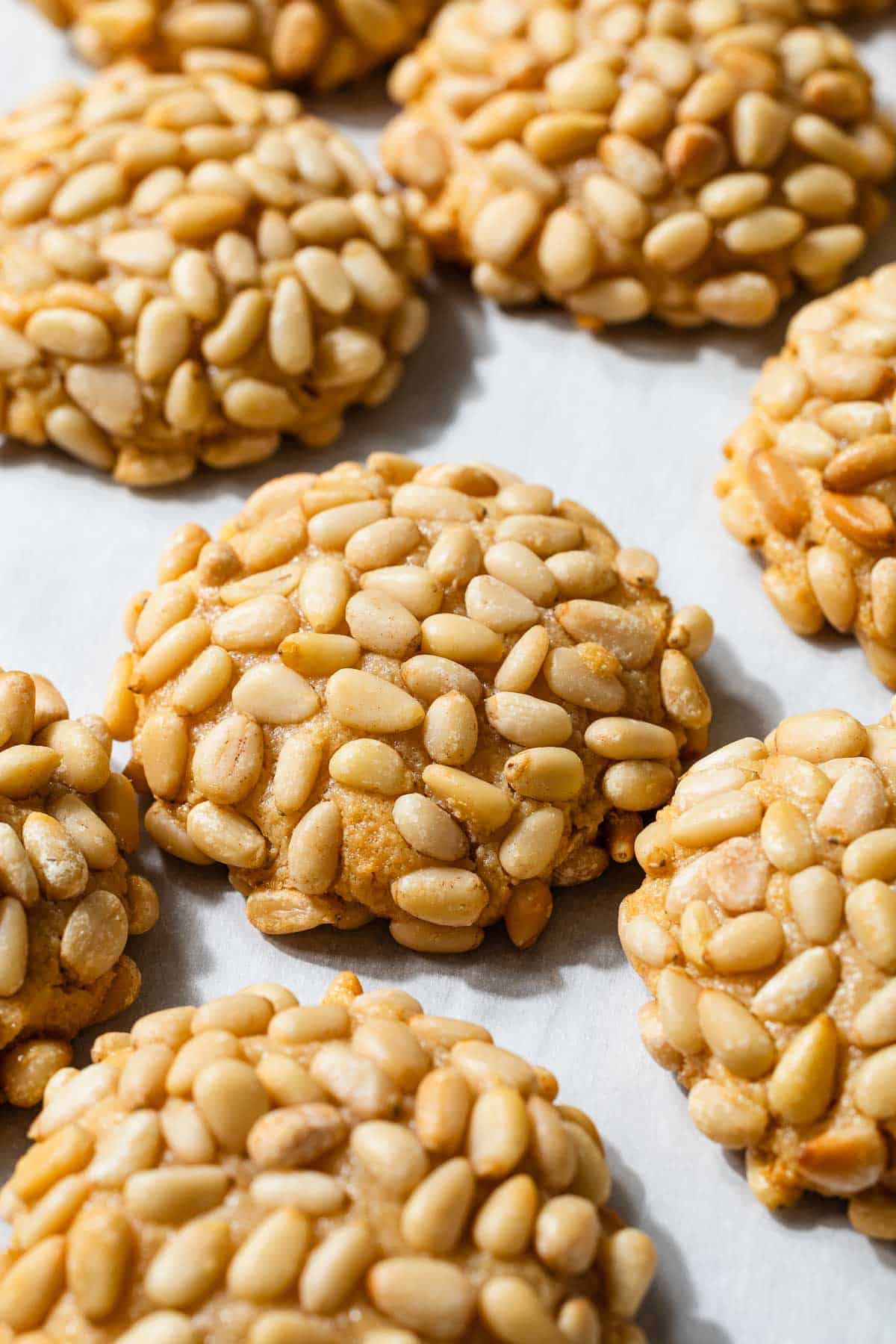
How to Adapt this Pignoli Cookie Recipe
As delicious as pignoli cookies are in their simplest form, you can easily customize them with your favorite flavorings.
- Play with the seasonings: I’m partial to adding a little orange zest and cinnamon—a flavor combination I crave during the holidays. Try adding 1/2 to 1 teaspoon of lemon or orange zest, 1/4 teaspoon of ground cinnamon, 1 teaspoon of vanilla extract, or 1/8 teaspoon of almond extract. Or mix and match.
- Try other nuts: Pignoli can also be made with other nuts instead of pine nuts. Use roughly chopped blanched almonds or blanched hazelnuts. Make sure the nuts are untoasted, as they’ll toast in the oven.
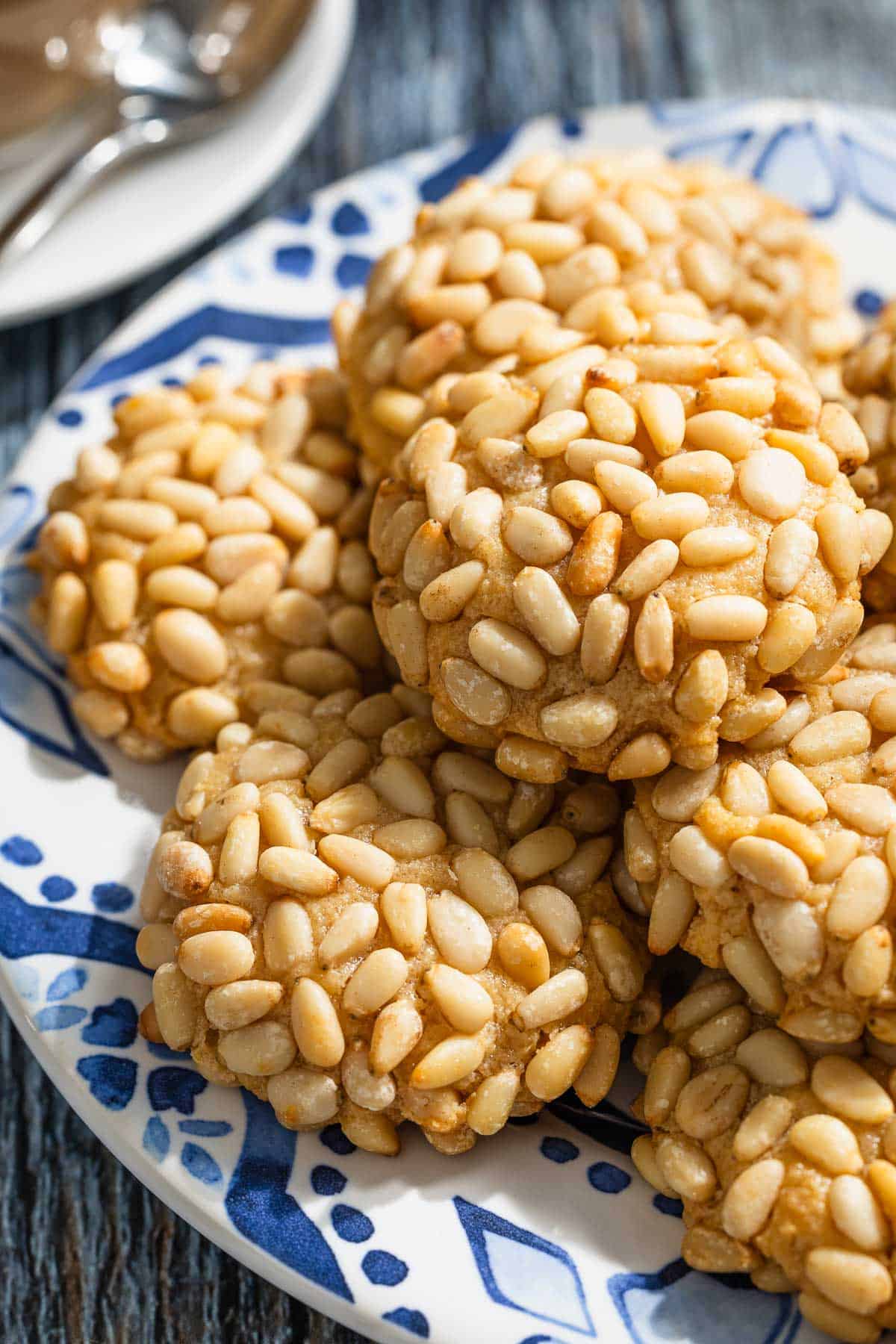
Make Ahead and Storage
The dough can be prepared a day or two in advance and kept in the refrigerator before scooping and coating in pine nuts. Store leftover pignoli cookies in an airtight container at room temperature for up to 5 days.
Pignoli cookies also freeze well, keeping for up to 1 month. After baking, let the cookies cool completely. Freeze them in a single layer on a parchment-lined tray, then transfer them to a freezer bag or freezer-safe container.
More Holiday Cookies from Around the Mediterranean
Browse all Mediterranean recipes.
Visit Our Shop
Get The Mediterranean Dish Cookbook
More than 120 recipes for bright and flavorful Mediterranean diet-inspired meals.

Pignoli Cookies
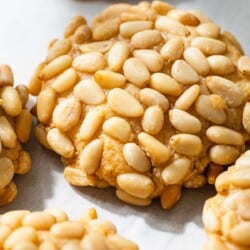
Ingredients
- 7 ounces (198g) almond paste
- 1/2 cup (100g) granulated sugar
- 1 large egg white
- 1/4 teaspoon kosher salt
- 1 cup (140g) pine nuts
Instructions
- Get ready. Arrange a rack in the center of the oven and preheat to 350°F. Line a baking sheet with parchment paper.
- Make the dough. Slice or break apart the almond paste into small pieces and add to the bowl of a food processor. Add the sugar, egg white, and salt, and process until it forms a thick, smooth paste, about 1 minute. Pause halfway through to scrape the bottom and sides of the bowl to ensure there are no unblended lumps of almond paste.
- Scoop the cookies. Scoop 12 rounded tablespoons of the dough (about 25g each) and roll each mound into a ball in the palms of your hand. If the dough is too sticky to work with, you can chill the dough, covered, for 10 to 15 minutes.
- Coat with pine nuts. Add the pine nuts to a wide, shallow bowl. Roll each ball of dough in the pine nuts, coating the entire surface. Gently press the pine nuts into the dough to encourage them to stick.
- Bake. Place the cookies on the prepared baking sheet, spacing them about 2 inches apart. Bake for 18 minutes, or until the pine nuts and the edges of the cookies begin to turn golden.
- Cool. Let the cookies cool completely on the pan before serving.
Notes
- Make sure to source almond paste, not marzipan. Marzipan tends to be much higher in sugar with a gummier texture, so it doesn’t make for a good substitute here.
- If you don’t have a food processor: Use a stand mixer with the paddle attachment. It will take a few minutes longer as you wait for the almond paste to form a smooth dough. Crumble the almond paste into small pieces and beat it with the sugar and salt until the almond paste has broken up into small pieces. Add the egg white and mix until smooth.
- If your dough is too sticky: The dough is naturally fairly sticky, which can be frustrating to work with. You can scoop the dough directly into the bowl of pine nuts, using the pine nuts as you would flour to prevent it from sticking to your hands while shaping the cookies. I found that chilling the dough in the fridge or freezer for a few minutes also helps as it gets stickier.
- To avoid breaking: After baking, let the cookies cool completely on the baking sheet. They’re delicate while warm and may break apart if they haven’t cooled and set.
- Visit our shop to browse quality Mediterranean ingredients including olive oils, honey, jams, and spices.



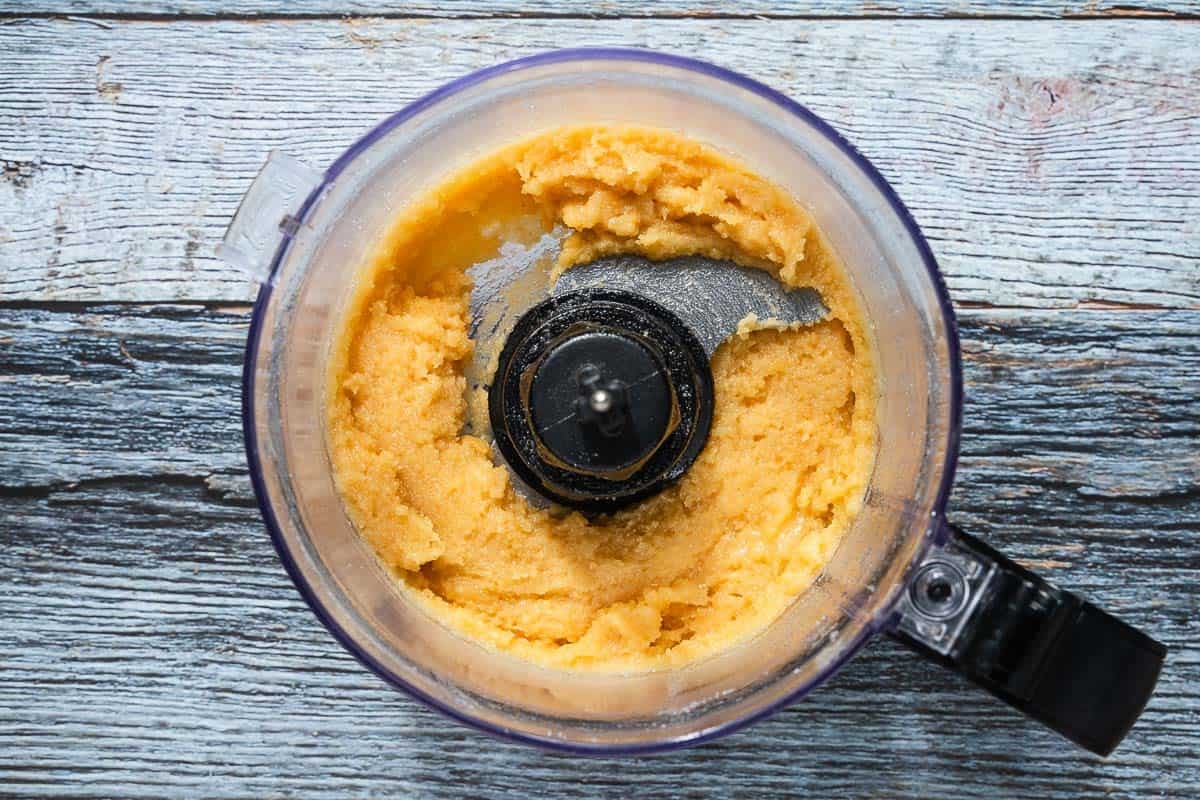
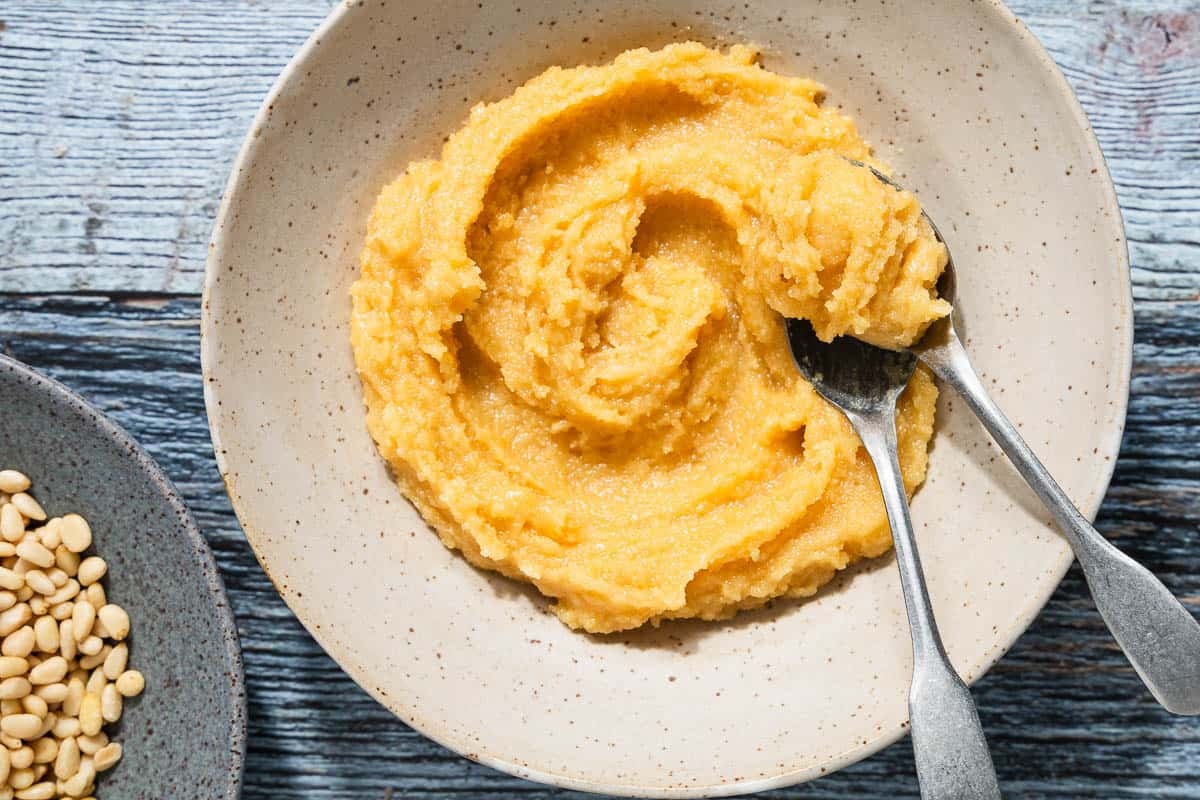
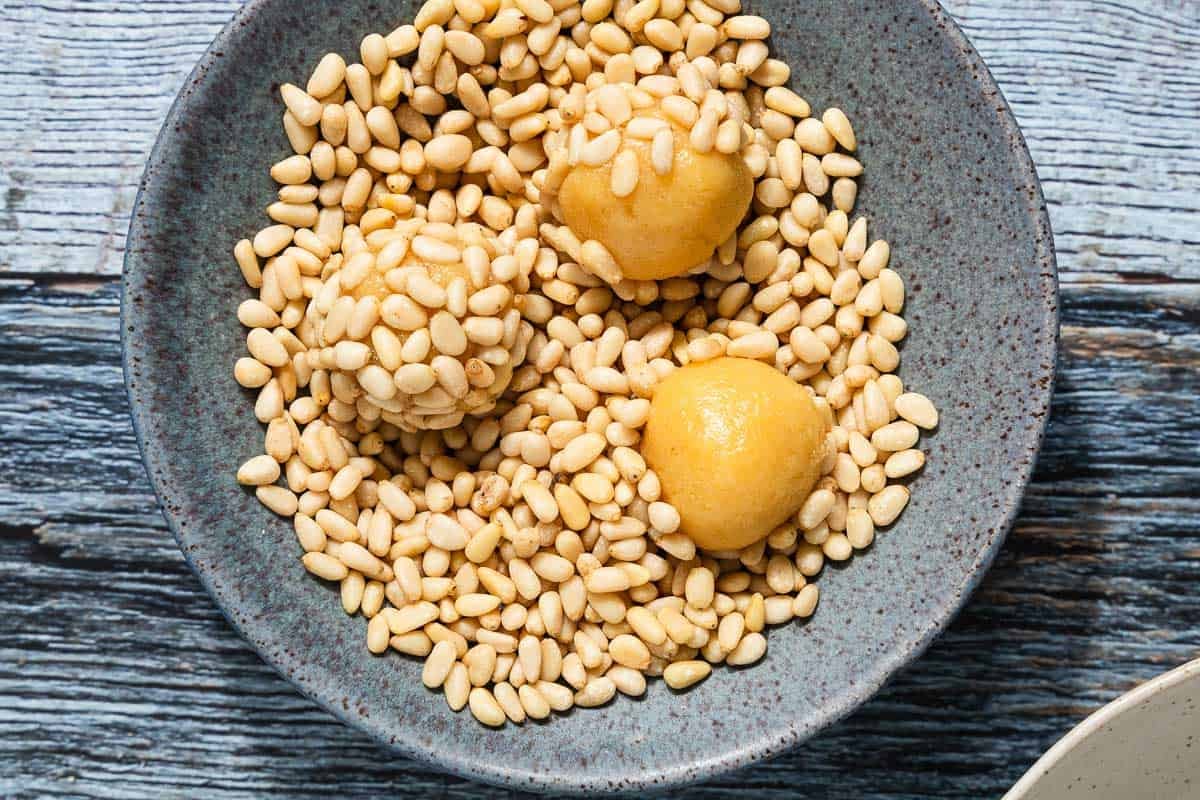
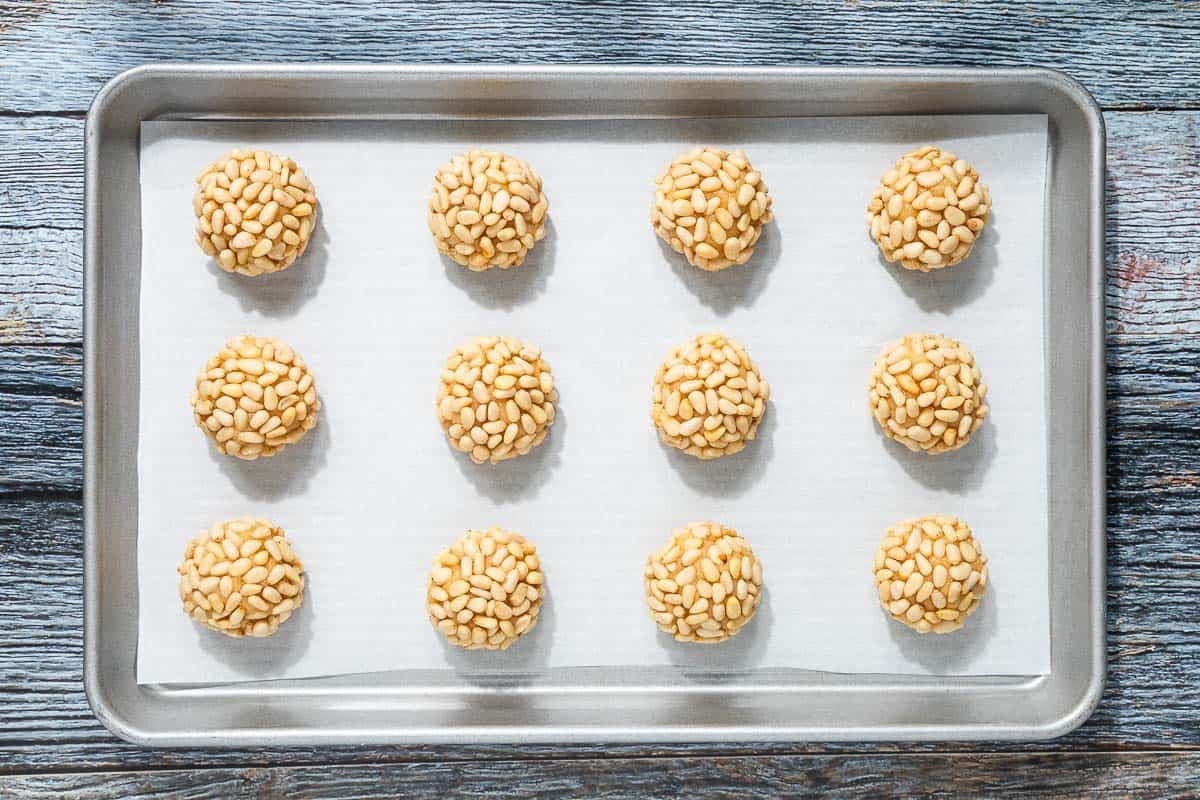
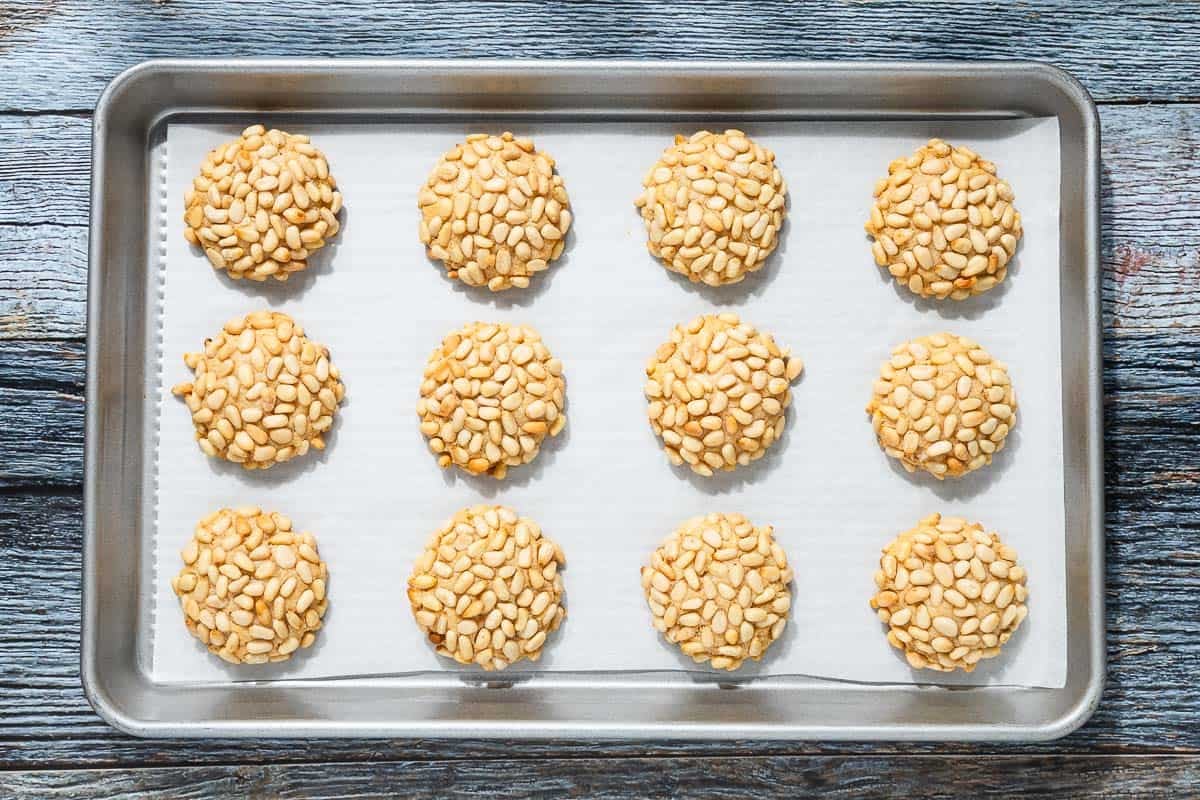

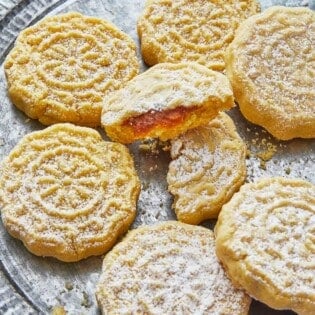
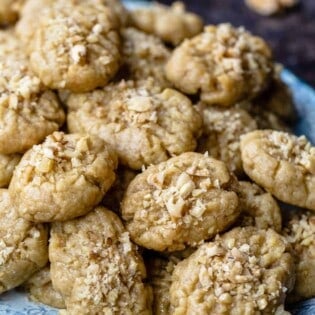
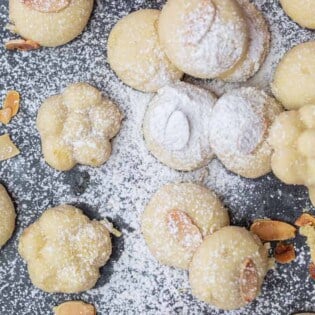
I worked at an Italian bakery in Portland Oregon… I loved making the Pignoli cookies. After putting them out one day I saw an older man buy one and take a bite. He nearly cried. Guess where he was from? Yes, Italy. I got quite a hug since that was my batch. This recipe is perfect!
Aww! That’s awesome!
if you happen to be in germany and are similarly confused as i am about the “no marzipan” note: don’t worry, Marzipanrohmasse (pure/raw marzipan) is the same as almond paste (see wikipedia for almond paste). Marzipanrohmasse is the “marzipan” found in the baking section and usually comes with more than 50% almond content, whereas marzipan in the sweets section is Marzipanrohmasse diluted down with more sugar and other ingredients. the recipe works perfectly fine with Marzipanrohmasse.
Thanks for sharing this, Fay. Super helpful!
I made these today for Christmas Eve. The recipe is simple and easy and they are delish. Husband loved them. But don’t try to make the cookie balls with your hands straight from the food processor. The paste is too soft. Put the bowl in the refrigerator as Suzy suggests. You’ll have a much easier time making cookies that are consistent.
Thanks for sharing, Michele! Merry Christmas!
Eureka! Finally a great pignoli cookie recipe! These are dense, chewy goodness. I did have to flatten them down a bit. I also chilled the dough which helped greatly. Thank you Suzy!
We just made these for the very first time and they are delicious! Thanks for the great recipe.
The ingredients must be well known because as my wife was checking out of the market the cashier asked her if she was making Pignoli.
Lol! Yes! Definitely a popular Italian cookie :).
I am so excited to try this recipe for Christmas! Can I use coconut sugar instead of granulated sugar? Thanks!
Hi, Adela! I’m Summer and I work here at The Mediterranean Dish. We haven’t tested it that way, so I can’t say for sure if it would work. But what is life if not an adventure! If you decided to try it please report back and let us know if the cookies turned out as expected or if you created a wonderful new kind of treat!